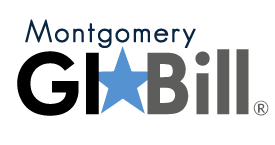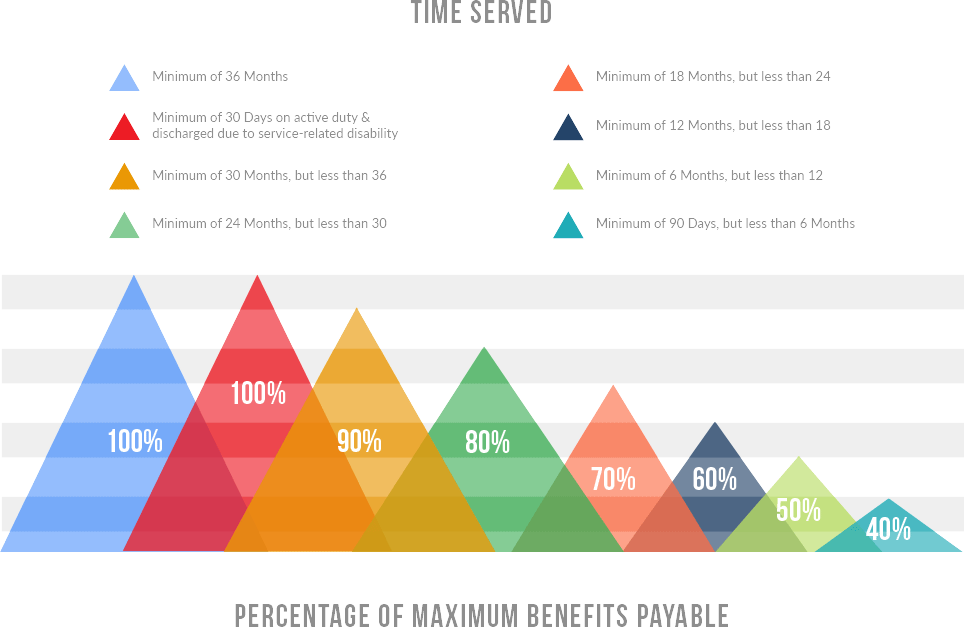In the past years, the government has put forth great financial efforts to encourage veterans to go back to school. According to the Department of Veterans Affairs, it is working. Military service members are going back to school and making use of the benefits offered by the government.
If you or someone you know has served in the military and want to go back to school, there are probably a good number of awards you qualify for on a governmental or institutional level. CollegeStats designed this guide to outline the different awards and programs that provide educational assistance to veterans and their dependents.
The GI Bill was designed by the Department of Veterans Affairs to encourage veterans to get the training and education they need to have a rewarding career. It helps by paying for tuition and housing, while guiding veterans to many different educational and training opportunities. While it all sounds simple, there are actually many facets to the system. First of all, there are two versions of the GI Bill. One is the Montgomery GI Bill, and the other is the Post-9/11 GI Bill. Let’s take a quick look at each and what they are all about:

In 1944, the original GI Bill was enacted for veterans of World War II. In 1984, this program was rebranded and called the Montgomery GI Bill. This bill is geared toward active duty members and honorably discharged veterans who served for at least two years. It is eligible for those who entered service after June 30, 1985 and paid the $1,200 enrollment fee. The Montgomery GI Bill contributes a set amount of funds every month to cover student expenses including tuition, housing, books, and other school fees.
Eligible veterans have up to ten years from the last day of their active duty service to redeem the 36 months of benefits. This program offers a monthly benefit payment made directly to the veteran, but the amount varies depending on the student’s length of service and the type of education he or she chooses.
The Montgomery program pays the veteran directly rather than paying the school. With that said, the student has more liberty in choosing where the money goes. It can go toward paying tuition, fees, books, and housing, to name a few. The amount paid will depend on length of service and what training or educational path the student chooses. For a list of rates, veterans can check out the U.S. Department of Veterans Affairs website.
A great benefit of the Montgomery GI Bill is that they offer the $600 Buy-Up Program. This program will allow students to receive up to $5,400 more in benefits if they increased their one-time $1,200 contribution by an extra $600.

If you are a veteran who served for at least 90 days after September 10, 2011, you should be eligible for the Post-9/11 GI Bill. This program expands educational benefits for veterans and active duty soldiers. How it works is benefits are given for 36 months for active duty members. Honorably discharged veterans have up to 15 years from their last day of service to claim their benefits.
The great thing about the Post-9/11 GI Bill is that it covers all of your tuition and fees. How great does free education sound? Of course, this will depend on your length of service and whether you choose to attend a public or private school. Full benefits are awarded to those who have served a minimum of three years. However, if you only have 90 days of service, you may still be eligible for as much as 40% of the total tuition coverage. This program also provides housing assistance (terms and conditions will depend on school) and a stipend of up to $1,000 each year for school supplies and books.
Unlike the Montgomery GI Bill, the student’s school is paid directly for tuition while the student is awarded money for housing, books, and supplies. Every year, students can get up to $1,000 for school supplies and textbooks. The allowance for housing will vary greatly depending on a variety of factors, such as cost of living near your school. If you’re wondering how much allowance you are eligible for, you can get an estimate using the military’s BAH calculator. Rural benefits may be awarded to certain veterans who qualify for a one-time payment of $500 to help them move from a rural area to their school.
The longer a student has served, the more benefits he/she is eligible for. Take a look at the chart below to get an idea of what percentages of maximum benefits are payable according to time served to see where you stand. Those enrolling at a public university will have all of their tuition and fees covered if they’ve served a minimum of 36 months or were discharged after 30 days due to a service-based disability. Students who have served less than that are still granted awards on an eligibility basis.


This program is good to know about if you plan on attending a private college or a university out-of-state. While the Post-9/11 GI Bill will cover up to 100% of the cost of tuition and fees for those attending public in-state colleges, it will not for those wishing to go to a private school or one out of state. The Yellow Ribbon Program is designed to make up for this difference to help those whose benefit amounts are limited.
The following individuals are eligible for Yellow Ribbon:
To get the Yellow Ribbon Program benefits:
If you meet the following criteria, you may qualify for the Yellow Ribbon Program:
The following is a list of the educational programs that Yellow Ribbon and Post-9/11 GI Bill covers:
It is important to note that not every college and university participates in the Yellow Ribbon Program. With that said, to participate as a student, your school has to agree to contribute a certain yearly amount. This amount will be matched by the VA. Schools that do choose to take part can also choose how many students they will sponsor every year. If you’re wondering whether the school you have in mind participates, this search tool will come in handy as it will tell you which school is enrolled in the program and how much they are contributing.
Applying for GI Benefits is a pretty simple process as long as you know what to expect, are prepared, and meet the deadlines. Here’s a quick step-by-step guide on applying for GI benefits:
Once you have been approved for GI Benefits, it’s time to consider the different ways to maximize them. Some tips are as follows:
Depending on your military service and how much money you qualify for under the GI Bill, you may want to look into scholarships to help pay for school. Scholarships are great because they are essentially gifted money that does not need to be repaid. Every scholarship offers different amounts and has their own requirements. Some worthy of checking out include:
On top of GI benefits are a ton of financial aid opportunities that are solely for veterans. Combining GI benefits with financial aid is a great way to earn a degree while eliminating financial stress, so that you can focus on your studies and increasing your worth in the job market. Below are a few of the main financial aid programs available to veterans.
There are several options to help make student loan payments bearable. There is the Income Based Repayment Plan, Income Contingent Repayment Plan, and the Standard Repayment Plan. These programs help to make the monthly payments match your income level, to minimize stress and strain on your finances. One great thing about these repayment plans, is that as a veteran you may be able to have your student loans completely discharged!
The Navy College Fund (NCF) is an addition to your basic allowance that is to be used towards higher education pursuits. It is not offered to every recruit as the budget is limited, but if you agree to serve for 3 or more years, graduated from high school, have an AFQT score of 50 or higher, and are between the ages of 17-35 then you may be able to benefit from this financial aid program. The amount added from the Navy College Fund to your basic allowance is called the ‘kicker’. The amount of your kicker will remain the same monthly amount for up to three years as long as you remain qualified for it.
The National Call to Service Program is an incentive program granted to those who serve on active duty for at least 15 months and then 24 months in an active status with the Selected Reserve. No break in service is allowed. You’ll then be able to benefit from one of the incentives of the program, which includes repayment of a qualifying student loan, up to $18,000.
A great benefit for veterans pursuing a career in medicine, is the Military Graduate Medical Education program. Through this program you’ll be able to select your specialty goal, and then be matched with a residency program in the Army or into a civilian program. Instructions for how to apply are published every July. You’ll be able to complete your entire residency without having to leave after internship to complete your General Medical Officer tour of duty. This is fantastic for those who have been matched to a great location and would rather not have to leave.
VEAP is a program for veterans where the government matches your contributions on a 2 for 1 basis. Contributions are made from your military pay. You’ll have 10 years after your release from active duty to use your VEAP benefits. If you don’t use this program, then your contributions will be refunded after the 10 year period. You’ll need to complete a VA Form 22-1990 and send it to the VA regional office to start the process.
The ROTC produces 75% of the officers in the Army. It’s a fantastic program to be apart of, to gain your degree as well as train for your military duties. The ROTC provides scholarships based on merit and grades rather than financial need. The program also gives monthly living allowances, depending on how far along you are in the ROTC program. There are also post-graduate scholarships for those pursuing a career in medicine.
VR&E provide counseling and services to help veterans get the most out of their VA benefits. Services range from job training, resume development, and job seeking skills. They’ll also guide veterans on how to start their own business. This is a fantastic program to get in touch with to speak with knowledgeable professionals in the VA on how to maximize your VA Benefits.
REAP has been largely replaced by the post-9/11 GI Bill, but some are still eligible until November 25th, 2019. If you are in the reserves and were called into active duty due to a war or national emergency, then you’ll want to look into your eligibility for this program in assisting your educational pursuits. If you’ve enrolled in school after November 25th, 2015 then you are not eligible and will want to look at your GI Bill benefits for equivalent assistance.
Current and former military service members are eligible for an assortment of education-related financial assistance. Every year, millions of dollars are awarded to veteran students and their spouses. If you or someone you know is on active duty or is a retired veteran, it will be worthwhile to check out the different types of financial aid available to make higher education more affordable. In addition to financial aid, there are also federal loans and grants available for consideration.